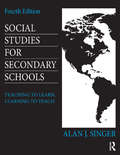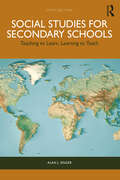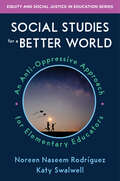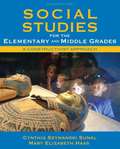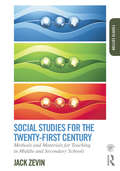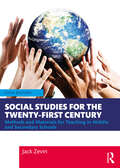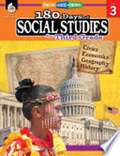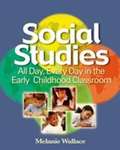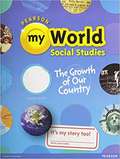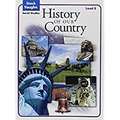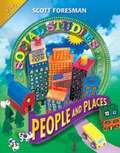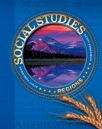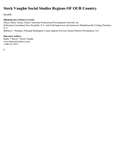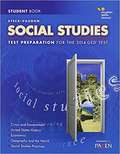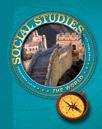- Table View
- List View
Social Studies class 6 - Andhra Pradesh Board
by State Council of Educational Research and Training Andhra PradeshThis book has 12 chapters. Students will be able to understand the concepts of pictures, Lets do, Do you know, Think and respond. Students should focus on Glossary, improve your learning and project works. Field visits will give more knowledge to students.
Social Studies class 7 - Andhra Pradesh Board
by State Council of Educational Research and Training Andhra PradeshThis book has 2 semesters. Each semester is divided into 6 units. Students will learn the topics are keyconcepts, Keywords, improve your learning, Activities and projectworks.
Social Studies for Secondary Schools: Teaching to Learn, Learning to Teach
by Alan J. SingerNow in its 4th edition, this popular text for secondary social studies methods courses integrates discussions of educational goals and the nature of history and social studies with ideas for organizing social studies curricula, units, lessons, projects, and activities. A major theme throughout is that what teachers choose to teach and the way they teach reflect their broader understanding of society, history, and the purpose of social studies education. Advocating an inquiry and activity-based view of social studies teaching that respects the points of view of students and teachers, and based in practice and experience, it offers systematic support and open, honest advice for new teachers. Each chapter addresses a broad question about social studies education; sub-chapters begin with narrower questions that direct attention to specific educational issues. Lesson ideas and materials in the book and online are especially designed to help new teachers to address common core learning standards, to work in inclusive settings, and to promote literacy and the use of technology in social studies classrooms. Chapters include highlighted Learning Activities, Teaching Activities, nd Classroom Activities designed to provoke discussion and illustrate different approaches to teaching social studies, and conclude with recommendations for further reading and links to on-line essays about related social studies topics. Activities are followed by four categories: "Think it over," "Add your voice to the discussion," "Try it yourself," and "It’s your classroom." All of these are supported with online teaching material. Designed for undergraduate and graduate pre-service social studies methods courses, this text is also useful for in-service training programs, as a reference for new social studies teachers, and as a resource for experienced social studies educators who are engaged in rethinking their teaching practice. New in the Fourth Edition Provides a number of new lesson ideas paired with online lesson plans and activity sheets in every chapter Takes a new focus on data-driven, standards-based instruction, especially in relation to the common core curriculum Addresses the interactive nature of learning in updated technology sections Reflects current trends in history education Includes more of what the author has learned from working teachers Offers a wealth of additional on-line material linked to the text
Social Studies for Secondary Schools: Teaching to Learn, Learning to Teach
by Alan J. SingerNow in its fifth edition, this popular text for secondary social studies methods courses integrates discussions of educational goals and the nature of history and social studies with ideas for organizing social studies curricula, units, lessons, projects, and activities. Advocating an inquiry and activity-based view of social studies teaching that respects the points of view of students and teachers, it offers systematic support and open, honest advice for new teachers.Based in practice and experience, lesson ideas and materials in the book and online are designed to help new teachers address Common Core learning standards, to work in inclusive settings, and to promote literacy and the use of technology in social studies classrooms. Chapters include highlighted Learning Activities, Teaching Activities, and Classroom Activities designed to provoke discussion and illustrate different approaches to teaching social studies and conclude with recommendations for further reading. Features of the fifth edition include: Activities called "Think it over," "Add your voice to the discussion," "Try it yourself," and "It’s your classroom” at the end of each chapter New topics such as the 1619 Project controversy, Stop WOKE campaigns, academic freedom, and legal restraints on 7–12 teachers New content on teaching literacy, including writing, reading, media, computer, and oral literacies Approaches to teaching advanced placement, international baccalaureate, and dual enrollment classes Multi-disciplinary and project-based teaching that combines history and social studies with the social sciences and other academic disciplines Links to the NCSS 3-C framework Information on becoming a professional leader through involvement in organizations like the NCSS and teacher unions Designed for undergraduate and graduate pre-service social studies methods courses, this text is also useful for in-service training programs, as a reference for new social studies teachers, and as a resource for experienced social studies educators who are engaged in rethinking their teaching practice.This text is supported by online materials, including discussion questions, lesson ideas, and links to lesson materials and activity sheets. You can find the resources here: https://alansinger.net/social-studies-for-secondary-schools/
Social Studies for a Better World: An Anti-oppressive Approach For Elementary Educators (Equity and Social Justice in Education #0)
by Noreen Naseem Rodriguez Katy SwalwellPlan and deliver a curriculum to help your students connect with the humanity of others! In the wake of 2020, we need today’s young learners to be prepared to develop solutions to a host of entrenched and complex issues, including systemic racism, massive environmental problems, deep political divisions, and future pandemics that will severely test the effectiveness and equity of our health policies. What better place to start that preparation than with a social studies curriculum that enables elementary students to envision and build a better world? In this engaging guide two experienced social studies educators unpack the oppressions that so often characterize the elementary curriculum—normalization, idealization, heroification, and dramatization—and show how common pitfalls can be replaced with creative solutions. Whether you’re a classroom teacher, methods student, or curriculum coordinator, this is a book that can transform your understanding of the social studies disciplines and their power to disrupt the narratives that maintain current inequities.
Social Studies for the Elementary and Middle Grades: A Constructivist Approach
by Cynthia Szymanski Sunal Mary Elizabeth HaasThis book discusses flexible strategies for teaching today's diverse learner, the structure of the knowledge to be learned, how to help students reconstruct present ideas, and how to translate theory and recent research into lesson plans and units. Packed with activities, up-to-date technology, teaching strategies, and a constructive approach, this text demonstrates how to use developmentally appropriate strategies to help students construct important social studies ideas and skills.
Social Studies for the Twenty-First Century: Methods and Materials for Teaching in Middle and Secondary Schools
by Jack ZevinNow in its 4th edition, this popular text offers practical, interesting, exciting ways to teach social studies and a multitude of instructional and professional resources for teachers. Theory, curriculum, methods, and assessment are woven into a comprehensive model for setting objectives; planning lessons, units, and courses; choosing classroom strategies; and constructing tests for some of the field's most popular and enduring programs. The reflective and integrative framework emphasizes building imagination, insight, and critical thinking into everyday classrooms; encourages problem-solving attitudes and behavior; and provokes analysis, reflection, and debate. The text includes separate chapters on teaching each of the major areas of the social studies curriculum. Throughout the text, all aspects of curriculum and instruction are viewed from a tripartite perspective that divides social studies instruction into didactic (factual), reflective (analytical), and affective (judgmental) components. These three components are seen as supporting one another, building the groundwork for taking stands on issues, past and present. At the center is the author's belief that the heart and soul of social studies instruction, perhaps all teaching, lies in stimulating the production of ideas; looking at knowledge from others' viewpoints; and formulating for oneself a set of goals, values, and beliefs that can be explained and justified in open discussion. New in the Fourth Edition: Clear links to the The National Council for the Social Studies College, Career and Civic Life C3 Framework for Social Studies State Standards Attention to impact of high-stakes testing, Common Core State Standards, and related ongoing developments Expanded and critical review of the use of internet, web, and PowerPoint technologies Coverage of how to incorporate the many social science, humanities, and STEM fields to enrich the social studies Updates and revisions throughout, including new research reports reflecting current findings, new examples, more media and materials resources, particularly digital resources, new and updated pedagogical features Companion Website - new for this edition
Social Studies for the Twenty-First Century: Methods and Materials for Teaching in Middle and Secondary Schools
by Jack ZevinNow in its 5th edition, this popular text offers practical, interesting, exciting ways to teach social studies and a multitude of instructional and professional resources for teachers. Theory, curriculum, methods, and assessment are woven into a comprehensive model for setting objectives; planning lessons, units, and courses; choosing classroom strategies; and constructing tests for some of the field's most popular and enduring programs. The reflective and integrative framework emphasizes building imagination, insight, and critical thinking into everyday classrooms; encourages problem-solving attitudes and behavior; and provokes analysis, reflection, and debate. Throughout the text, all aspects of curriculum and instruction are viewed from a tripartite perspective that divides social studies instruction into didactic (factual), reflective (analytical), and affective (judgmental) components. These three components are seen as supporting one another, building the groundwork for taking stands on issues, past and present. At the center is the author's belief that the heart and soul of social studies instruction, perhaps all teaching, lies in stimulating the production of ideas; looking at knowledge from others' viewpoints; and formulating for oneself a set of goals, values, and beliefs that can be explained and justified in open discussion. This new edition is heavily revised and condensed to promote ease of use. "Build Your Own Lesson" additions to each chapter encourage improvisation and inquiry-based teaching and learning across subjects. A Companion Website offers additional activities, lessons, and resources for pre-service and practicing social studies teachers.
Social Studies, Level 3: Practice, Assess, Diagnose (180 Days Of Practice)
by Shell Education Shell Education180 Days of Social Studies is a fun and effective daily practice workbook designed to help students build social studies content knowledge. This easy-to-use third grade workbook is great for at-home learning or in the classroom. The engaging standards-based activities cover grade-level skills with easy to follow instructions and an answer key to quickly assess student understanding. Each week students explore a new topic focusing on one of the four social studies disciplines: history, civics, geography, and economics. Watch student s confidence soar as they build analytic skills with these quick independent learning activities. <p><p> Parents appreciate the teacher-approved activity books that keep their child engaged and learning. Great for homeschooling, to reinforce learning at school, or prevent learning loss over summer. <p> Teachers rely on the daily practice workbooks to save them valuable time. The ready to implement activities are perfect for daily morning review or homework. The activities can also be used for intervention skill building to address learning gaps. Supports the C3 Framework and aligns to the NCSS curriculum standards.
Social Studies: All Day, Every Day in the Early Childhood Classroom
by Melanie WallaceSocial Studies - All Day, Every Day, is a research based text containing the latest research on learning styles, reading and math, and best practices. In light of the recent No Child Left Behind legislation, many teachers of young children are opting out of teaching social studies in favor of spending more time on reading and math instruction. Not only is this inappropriate and unfair to the students, it is unnecessary. In this text, the reader will discover ways to study in-depth, a wide range of the social studies, while spending the necessary time and intellectual energy developing reading and mathematical skills. The opening chapters of the text define the social studies and describe the National Council of Social Studies (NCSS) standards as they relate to teaching young children. The remainder of the text breaks down teaching methodology for working with young children and the social studies, and looking at individual disciplines within the social studies. Practical application, with a theoretical base, is the key to this text.
Social Studies: California
by Harcourt BraceThis book provides standard state coverage: geography, history, government and economy, population, achievements and landmarks. A final section contains basic facts and interesting tidbits of information.
Social Studies: Communities Around Us
by James B. Kracht Deborah Gray White Juan R. Garcia Daniel J. Gelo Linda L. GreenowThis book is built up on four themes viz., Learning About Communities, Different Kinds of Places, Communities Yesterday and Today, People and Citizenship. Also included are Maps, Time Line, Graphs, Tables, and Diagrams, Skills and Literature for optional reading.
Social Studies: Grade 5B
by Scott ForesmanYour child is ready to complete his or her primary homeschool programs, which means you need a challenging Social Studies curriculum. myWorld Social Studies: Grade 5B/6 is the final stage in the myWorld Social Studies series. The curriculum for homeschooling uses the best in educational research and effective storytelling techniques to ensure your child completes his or her primary education with a solid grasp of the subject. <p><p> This step in myWorld Social Studies continues right where Grade 5A left off, giving both you and your child a seamless transition from one curriculum to the next. Additionally, the program will set your child up for their secondary educational journey. By the time you reach the conclusion of myWorld Social Studies, your child should be able to: <p><p> Use a variety of source types (such as first-hand accounts, textbooks, both fiction and nonfiction texts, etc.) to deepen his or her understanding of important historic events. Understand that not all accounts are accurate and discern between a reliable and unreliable narrator. Display understanding of current events by completing assignments and reports on timely topics. Recall the roots of modern civilization, including facts on ancient Egypt, Greece and Rome. Understand two sides of world events (such as wars). Recount the development of the American colonies and how they became a nation. Participate in community service events. Understand local, state and national governments, and how they work both independently and together. <p><p> The myWorld Social Studies homeschool program aims to help your child become an active, engaged and responsible citizen while simultaneously learning about important historic events. Additionally, your child will understand geography and how it connects to other areas of Social Studies. For more information about the specific items included in myWorld Social Studies: Grade 5B/6, visit the Features and Benefits page.
Social Studies: History Of Our Country, Level E
by Steck-Vaughn StaffHistory Of Our Country: Social studies textbook on the history of America.
Social Studies: Making a Difference
by Harcourt BraceThis volume looks at the world, life in different countries, different culture, habits, living, community services and social studies.
Social Studies: Regions
by Candy Dawson Boyd C. Frederick Risinger Geneva Gay Rita Geiger James B. Kracht Valerie Ooka Pang Sara Miranda SanchezSocial studies textbook.
Social Studies: Regions Of The Country (Steck-vaughn Social Studies)
by Steck-Vaughn StaffExplore the beauty of regions around the United States. Teach your students what different areas look like and how they come together to be a unified country. Teach them the complex, yet essential, roles the USA has with Regions of Our Country Level D Student Book by Steck-Vaughn. Challenge your students as they experience the diversity around them!
Social Studies: States and Regions (Harcourt School Publishers Social Studies)
by Harcourt Brace*This textbook has been transcribed in UEB, formatted according to Braille textbook formats, proofread and corrected. <P><P>"Every one of you already holds the important office of citizen. Over time you will become more and more involved in your community. You will need to know more about what being a citizen means. Social studies will help you learn about citizenship. That is why social studies is important in your life."
Social Studies: Test Preparation for the 2014 GED Test (Steck-Vaughn GED)
by Steck-Vaughn CompanyThe newest edition of the GED® test presents a range of fresh challenges to learners and educators in Spanish. Now Houghton Mifflin Harcourt offers you an accelerated yet complete approach to deliver positive test results faster with Steck-Vaughn Test Preparation for the 2014 GED® Test.
Social Studies: The World (Grade #6)
by Candy Dawson Boyd Jim Cummins Lee A. Chase Allen D. Glenn Carole L. Hahn M. Gail Hickey Bonnie Meszaros"Social Studies, The World" contains topics on Early Civilizations and Cultures, Early Civilizations in Africa and Asia and the Americas, Mediterranean Empires, The Medieval World, Discovery, Expansion, and Revolutions, A World in Opposition, New Nations and a New Century, etc. Reference Guide, Biography, Maps, Skills, Charts, Graphs, Tables & Diagrams, Time Lines, Social Studies Handbook are additional features of this book.

